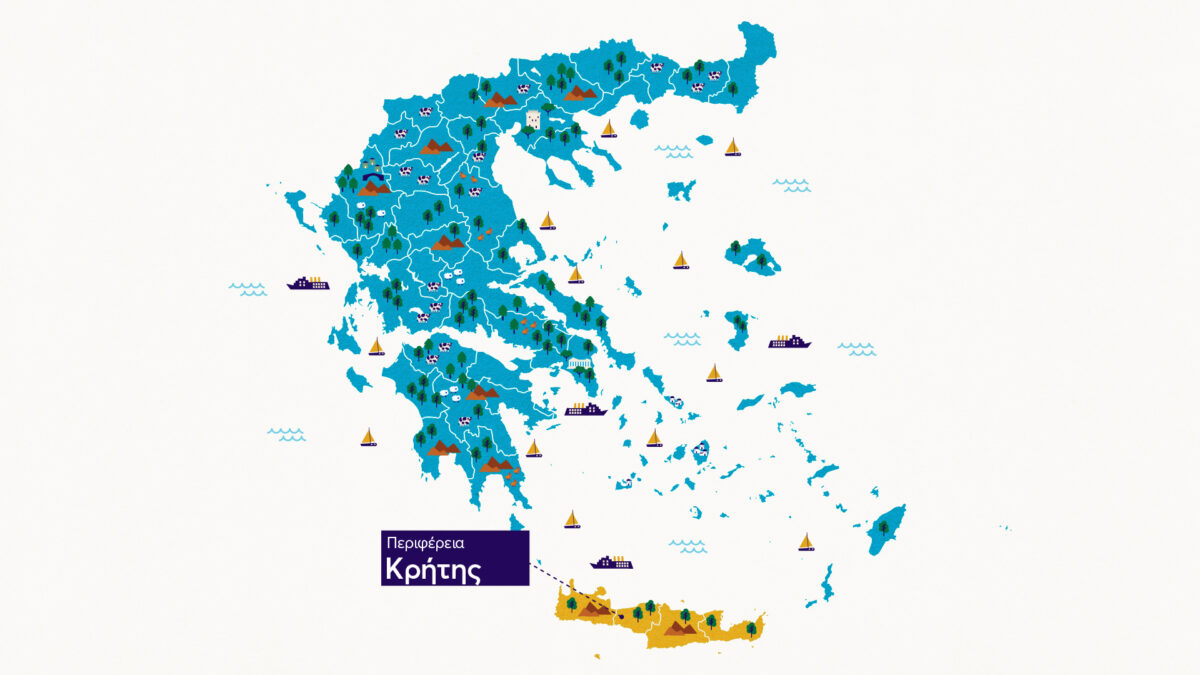The Region of Crete is an island Region which sits at Greece’s southernmost extremity. It encompasses four Regional Units: Heraklion, Lasithi, Rethymno and Chania.
Crete is Greece’s largest island and one of the most prominent in the Mediterranean. It boasts a rich, multi-faceted history extending over thousands of years of cultural and political developments. The island was the birthplace of the Minoans, considered Europe’s first organised culture and civilisation. Visitors can experience the archaeological remains of this people at the Knossos archaeological site. Due to its strategic position, Crete has had a tumultuous history, becoming a theatre for major conflicts from Medieval times right through the Ottoman period and into the modern day. It was incorporated into the Greek state in 1913 by virtue of the Treaty of London, signed after the First Balkan War. During WWII, the island was heavily contested between the Allies and the Nazis, and the Cretan resistance became legendary.
The successive cultures which controlled the island through the centuries are reflected in its architecture, which exhibits an eclectic and fascinating mix of cultural and historical influences. The island’s rich history and the imprints of successive Mediterranean cultures are reflected in the ornate Minoan palaces, Byzantine monasteries, Venetian fortresses and Ottoman mosques scattered throughout it.
In addition, Crete is the birthplace of prominent individuals such as the renowned author Nikos Kazantzakis, Nobel laureate Odysseas Elytis, the painter Dominikos Theotokopoulos (El Greco), the poet Vitsentzos Kornaros, the musician Nikos Xylouris, and last but certainly not least, the seminal modern Greek politician, Eleftherios Venizelos.
Crete has a unique character, exuding freedom, autonomy and self-sufficiency. With their shared Cretan temperament, each of the island’s cities nevertheless exhibits its own unique character. As a result, visitors to the island can experience “a whole world”. Crete’s size, varied landscapes and scenic wealth, in which each village and settlement has its own history, together weave the tapestry of the “Cretan world”.
Indeed, Crete is the ideal Mediterranean travel destination. Visitors are sure to be enchanted by what the island has to offer: from the majestic Mt Psiloritis which towers over the island at 2,456 metres above sea level to the over 1,046 kilometres of coastline, to its verdant plains, imposing mountains and spectacular beaches. Visitors should take the opportunity to immerse themselves in the unique beauty of the Palm Forest at Vai in Agios Nikolaos, Lasithi, the Samaria Gorge in southwestern Crete, the exotic Preveli beach in Rethymno and the picturesque Archanes, a traditional Heraklion village.
Crete also has an exciting local cuisine, shaped by the various influences on the island, its geographic location and its contacts with various different cultures. These aspects have given rise to a one-of-a-kind culinary tradition which brings together local raw materials, ancient recipes and influences from conquerors and neighbouring cultures.
Indeed, given the island’s functional autonomy, fertile lands, rich waters and extensive livestock farming, there’s no limit to the flavours available for those who want to sample them, including olive oil, honey, anthotyro from fresh milk, graviera cheeses packed with flavour, and apaki, the local pork cold cut. The picture is rounded out by traditional barley rusks and local pasta. Recipes use local products to create explosions of flavour. Prominent local delicacies include sautéed stamnagkathi (spiny chicory) and fried chochlioi (snails). And no Cretan table is complete without a helping of thin fried sfakianopites or the festive kreatotourta. And of course there are sweet kaltsounia, pies filled with anthotyro, honey and cinnamon, enjoyed both at breakfast and as dessert. Everything is accompanied by a glass of the local wine or a shot of tsikoudia (or rakomelo), all traditional local drinks intimately connected with social life on the island.
Overall, Crete is both a self-sufficient and a vitally important cultural, historical and tourism destination, boasting a unique heritage that is on full display in its archaeology, art and traditions.










